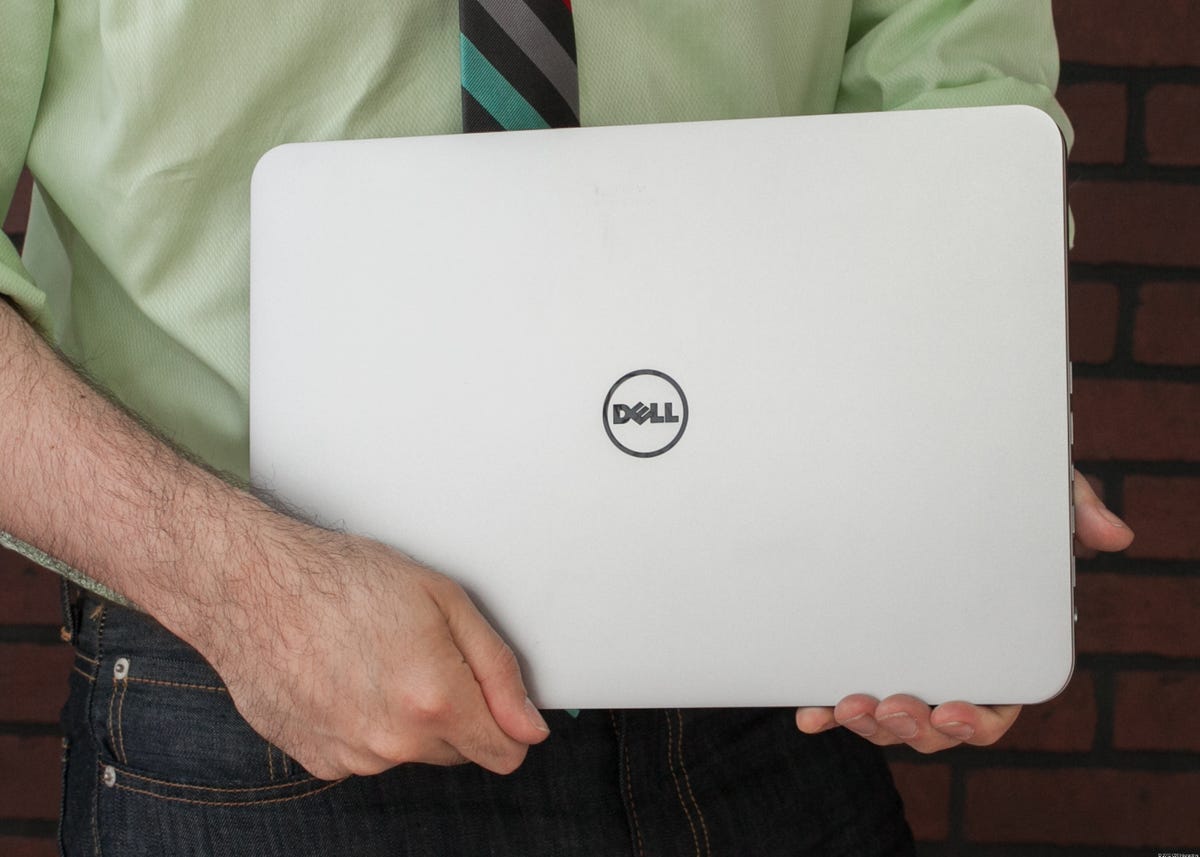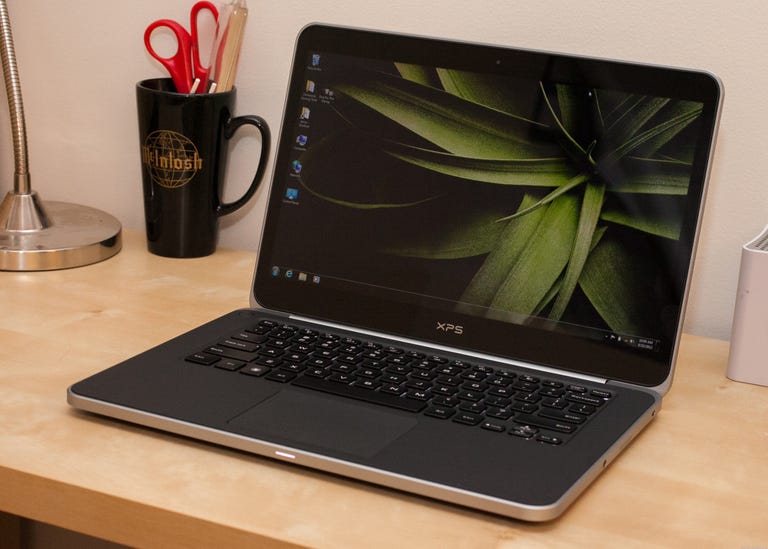 Why You Can Trust CNET
Why You Can Trust CNET Dell XPS 14 review: Dell XPS 14
The Dell XPS 14 is a worthy competitor to the MacBook Pro, though it's a bit heavier than we'd like.
Forget the image of Dell laptops as generic-looking plastic boxes (or, less generously, cheap-looking ones). The past couple of generations of both Inspiron and XPS laptops -- the company's mainstream and high-end lines, respectively -- have been moving in the right direction in design, even if dragged there by the growth of Apple's MacBooks and the push toward thinner, snazzier ultrabook-style laptops.
The Good
The Bad
The Bottom Line
The latest revamps of the Inspiron and XPS laptops are the best either system has ever looked, and the new flagship may well be the 14-inch XPS 14. A midsize version of the Dell XPS 13 we saw earlier in the year, this is a similarly solid, slablike system, with an eye for aesthetic minimalism but with enough extra features, from a higher-res display to a backlit keyboard to a DisplayPort jack, to feel premium. Our review sample included an Intel Core i7 CPU and discrete Nvidia GeForce 630M graphics, for $1,499.
There are a still a couple of things that give me pause. This is a thin midsize laptop, but it's heavier than any 14-inch laptop without an optical drive needs to be. Too heavy to be a laptop for serious daily commuting, to be sure. I said the same thing about the recent MacBook Pro with Retina Display, which weighs a little less (4.46 pounds versus 4.7 pounds), but has a larger 15-inch screen.
And, if you want a thin 14-inch ultrabook laptop with a third-generation Intel Core i-series processor, discrete graphics, and a combination of solid-state drive (SSD) and hard-drive storage, Dell's recent Inspiron 14z may also fit the bill, for a few hundred dollars less (and it weighs only 4.1 pounds). The Inspiron tops out at a Core i5 CPU, the screen resolution is lower, and the graphics come from AMD, not Nvidia, but our review configuration of that system cost $899, versus $1,199 for an otherwise comparable XPS 14. Plus, the Inspiron 14z is a pretty sharp-looking system, especially considering the price. No, it's not as sharp, as configurable, or as solidly built, as the XPS 14 reviewed here, but hey, it's your money.
| Price as reviewed / Starting price | $1,499 / $1,099 |
| Processor | 1.9GHz Intel Core i7-3517U |
| Memory | 4GB, 1,333MHz DDR3 |
| Hard drive | 500GB 5,400rpm / 32GB SSD |
| Chipset | Intel HM77 |
| Graphics | Nvidia GeForce GT 630M / Intel HD 4000 |
| Operating system | Windows 7 Home Premium (64-bit) |
| Dimensions (WD) | 12.2x9.2 inches |
| Height | 0.8 inch |
| Screen size (diagonal) | 14 inches |
| System weight / Weight with AC adapter | 4.7 pounds / 5.7 pounds |
| Category | Midsize |
Over the years, the XPS brand from Dell has gone through many different designs, but the current look seems best suited for the overall theme of a high-end laptop that mixes productivity with premium materials and construction. This generation of XPS laptops started with the XPS 13 earlier in 2012, which was also Dell's first ultrabook.
That 13-inch system was also made of machined aluminum, and its tapered design clearly (and no doubt deliberately) brought to mind Apple's MacBook Air (we jokingly called it the DellBook Air at the time). The XPS 14, and its big brother, the also-new XPS 15, are similar, but not identical. The aluminum outer chassis in this case is combined with a magnesium alloy wrist rest and a soft-touch silicone bottom panel. These larger XPS laptops are more slablike, rather than tapered. One could even say they look more like the MacBook Pro than the Air, from the matte aluminum finish to the black, backlit keyboard to the large one-piece clickpad (and the sealed battery compartment).

The XPS 14 feels as solidly built and as sturdy as any nonrugged laptop I've tested. I'm not sure it would stop a bullet, but it would definitely do some damage if you dropped it onto a glass coffee table. The flipside of that is the system's weight. Dell says the XPS 14 starts at 4.6 pounds, I weighed our review unit and it was exactly 4.7 pounds, without the power cable. Note that that's also without an internal optical drive.
There's no way around the fact that it feels heavier than it looks, and is likely too heavy to be a frequent travel accessory. That's a shame, as it's labeled as an ultrabook, meaning only that it meets Intel's requirements for a 14-inch laptop, which may be surprisingly different from what you thought an ultrabook should be. As mentioned previously, both the Dell Inspiron 14z and the new Apple MacBook Pro with Retina Display weigh less.
Once you get past that, the interior ergonomics are excellent, with a keyboard that's similar to the island-style ones found in systems from Apple, Sony, and others. The backlight is strong, and the shift, Tab, CTRL, and other important keys are a good size. Only the four directional arrows seem to get shortchanged a bit.
The large, button-free, multitouch click pad is a design we see more often now. This iteration works especially well with multitouch gestures, such as two-finger scrolling, and is as responsive as any I've tried, save for Apple's MacBooks. If you dive into the settings menu for the touch pad, there's an inertial scrolling option that can be turned on, but I found it to be imprecise and not all that helpful.
The 14-inch display has a native resolution of 1,600x900 pixels, which is really the sweet spot for a midsize laptop. The more common 1,366x768-pixel resolution is too low, especially as you get into more expensive laptops, and 1,920x1080 pixels, which you sometimes find on premium systems, is unnecessarily high for many people. Interestingly, Apple's Retina Display MacBook Pro throws a wrench in this, with its 2,880x1,800-pixel screen that can be set to mimic several different resolutions. In the XPS 14, the screen was bright, with edge-to-edge Corning Gorilla Glass over it, but with a disappointingly small optimal viewing angle. Move just a little bit off-axis vertically, and the image deteriorates quickly.
| Dell XPS 14 | Average for category [midsize] | |
|---|---|---|
| Video | HDMI, mini-DisplayPort | VGA plus HDMI or DisplayPort |
| Audio | Stereo speakers, headphone jack | Stereo speakers, headphone/microphone jacks |
| Data | 2 USB 3.0, SD card reader | 2 USB 2.0, 2 USB 3.0, SD card reader, eSATA |
| Networking | Ethernet, 802.11n Wi-Fi, Bluetooth, optional mobile broadband | Ethernet, 802.11n Wi-Fi, Bluetooth, optional mobile broadband |
| Optical drive | None | DVD burner |
Nearly all the ports and connections are gathered on the left side of the system, which is hopefully where you like them, unless you don't mind wrapping cables all over the place. On the right side, where an optical drive slot or tray would normally go, is a single SD card slot. Both USB ports are 3.0 (much as Apple made the same 3.0-only switch), and in the future, I suspect we'll see fewer and fewer USB 2.0 ports on laptops in any price range.
This particular configuration runs $1,499, and includes an Intel Core i7-3517U, along with 8GB of RAM, Nvidia's GeForce GT 630M GPU, and a 500GB hard drive, coupled with 32GB of quick SSD storage. You can get as low as $1,099, with a Core i5 CPU and no discrete graphics, but that seems pointless when similar configurations are available from other laptops for so much less. Note that a couple of the available configurations have only a 500GB HDD, without the 32GB SSD, making them not technically ultrabooks.
In our CNET Labs benchmark tests, the XPS 14 powered through faster than the Core i5 Inspiron 14z, but slower than Apple's quad-core version of the 15-inch MacBook Pro. In single-app tests, the performance was close to that of the Maingear EX-L 15, another new Ivy Bridge laptop, but one pitched exclusively for its performance. That's all to say that the specs here are more than powerful enough for any task you're likely to throw at the XPS 14, and you could even elect to jump back to the less expensive Core i5 version and not even notice the difference.
While the XPS 14 has a discrete graphics card -- something of a rarity for ultrabooks of any size -- it's Nvidia's GeForce 630M, which is considered a mainstream part, not one for hardcore gamers. It's still more than adequate for casual games, and you'll be able to play most current games if you turn down the detail settings a bit.
In our low-end Street Fighter IV test, at 1,600x900 pixels, the XPS 14 ran at a decent 43.4 frames per second. The more challenging Metro 2033 test ran at 11.7 frames per second at 1,366x768 pixels, which is actually not a terrible score. Interestingly, we got about the same levels of performance from the other new Dell 14-inch ultrabook, the Inspiron 14z, which has discrete AMD graphics instead.
With a high-powered CPU and discrete graphics, you'd be right to worry about the battery life on the XPS 14. Fortunately, a big chunk of that 4.7 pounds must be battery, because the system ran for 6 hours and 8 minutes in our video-playback battery-drain test. That's within an hour of the 15-inch MacBook Pro, and great for any midsize laptop. This is one area where the XPS model beat the Inspiron handily, by more than an hour.
Dell offers a special level of service and support for XPS products, which is always welcome. As the XPS 14 hasn't gone live on Dell's Web site as of this writing, we'll have to update the details on exact warranty options and upgrades when that information is available. On previous XPS laptops, Dell has offered a default one-year mail-in service warranty, along with 24-7 toll-free phone service and Web support, including documentation and software drivers that are easy to find.
The Dell XPS 14 continues to stretch the definition of an ultrabook, and not particularly for the better. I loved the overall design, and the inclusion of high-end components, including discrete graphics. However, for $1,499, I expected a full SSD drive, as ultrabooks with 128GB SSD drives are available for as little as $800. All that aside, the biggest hurdle for the XPS 14 is its weight. While 4.7 pounds doesn't sound like a lot for a midsize laptop, it feels incredibly heavy for its slim size compared with other slim midsize laptops we've reviewed.
(Shorter bars indicate better performance)
(Shorter bars indicate better performance)
(Shorter bars indicate better performance)
(Longer bars indicate better performance)
Find out more about how we test Windows laptops.
System configurations
Dell XPS 14
Windows 7 Home Premium (64-bit) w/ SP1; 1.9GHz Intel Core i7-3517U; 8GB DDR3 SDRAM 1,333MHz; 1GB Nvidia GeForce GT 630M / 64MB (Dedicated) Intel HD 4000; 500GB Hitachi 5,400rpm
Apple MacBook Pro 15.4-inch (Summer 2012)
OS X 10.7.3 Lion; 2.3GHz Intel Core i7-3610QM; 4GB DDR3 SDRAM 1,600MHz; 512MB Nvidia GeForce GT 650M / 384MB (Shared) Intel HD 4000; 500GB Hitachi 5,400rpm
Dell Inspiron 14z-5423
Windows 7 Home Premium (64-bit) w/ SP1; 1.7GHz Intel Core i5-3317U; 8GB DDR3 SDRAM 1,333MHz; 1GB (Dedicated) AMD Radeon HD V18 + Intel HD 4000; 500GB Hitachi 5,400rpm
Maingear EX-L 15
Windows 7 Home Premium (64-bit) w/ SP1; 2.7GHz Intel Core i7-3820QM; 8GB DDR3 SDRAM 1,333MHz; 2GB Nvidia GeForce GTX 675M + 64MB (Dedicated) Intel HD 4000; 750GB Seagate 7,200rpm
Asus Zenbook UX32V
Windows 7 Home Premium (64-bit) w/ SP1; 1.9GHz Intel Core i7-3517U; 4GB DDR3 SDRAM 1,333MHz; 1GB Nvidia GeForce GT 620M + 64MB (Dedicated) Intel HD 4000; 500GB Hitachi 5,400rpm


